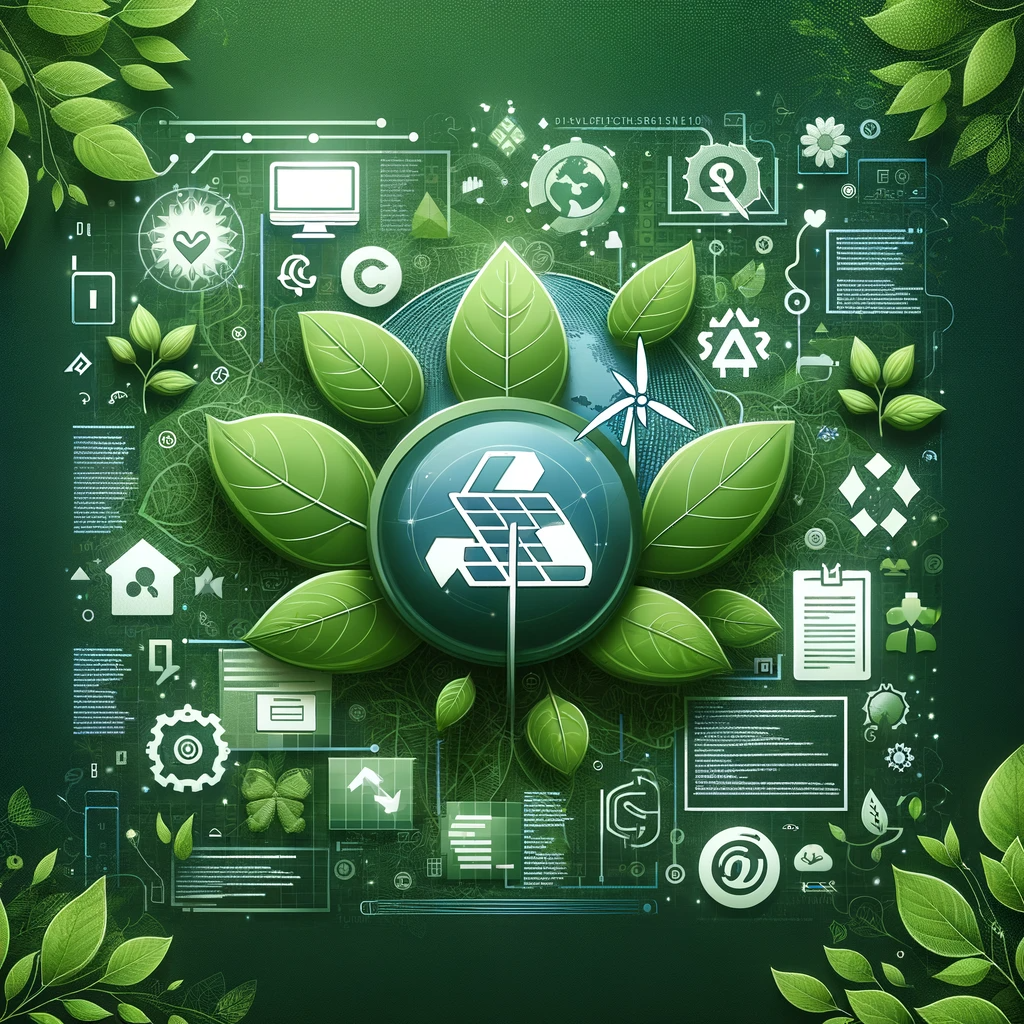
Crafting a Greener Future: Mastering Sustainable Web Design Practices to Minimize Your Website's Carbon Footprint
This post may contain affiliate links, which means I may receive a commission if you click a link and purchase something that I have recommended. Thank you!
In an era where digital presence is pivotal, the importance of sustainable website design cannot be overstated. With the increasing digital carbon footprint, it's essential to consider how our online activities impact the environment. This article delves into sustainable web design practices to reduce the carbon footprint of your website, paving the way for an eco-friendly and environmentally friendly digital future.
Understanding the Digital Carbon Footprint in the Modern Digital Era
The digital carbon footprint encompasses the carbon emissions generated by our online activities. This includes energy consumption from various sources: data centers that store and manage web information, the networks transmitting this data, and the personal devices we use, like computers and smartphones.
These emissions are not just limited to active usage but also involve the supporting infrastructure. For example, cooling systems in data centers significantly add to the energy used. Understanding this footprint is key. It's the first step in realizing the environmental impact of our digital choices and the importance of sustainable web practices.
The Imperative of Sustainable Web Design for Environmental Sustainability
Sustainable web design is more than a passing trend; it's an imperative adaptation in our digital practices. This approach aims to minimize the environmental impact of online activities. By incorporating sustainable methods — such as energy-efficient coding and eco-friendly hosting — web design can play a pivotal role in reducing carbon emissions.
This shift to sustainability is not just about the environment. It also enhances a website's performance and user experience, crucial for audience retention and search ranking. Moreover, it demonstrates a commitment to environmental responsibility, aligning with the values of eco-conscious consumers.
Minimalist Design: A Key to Eco-Friendly and Sustainable Website Design
Minimalist design offers a unique blend of aesthetics and environmental responsibility. It's about using fewer, strategically placed design elements, which translates to less data for browsers to load. This reduction eases the load on servers, cutting down carbon emissions.
But it's not just about emissions. Minimalism in web design also streamlines user experience. It offers faster load times and a clearer focus on essential content, making websites more user-friendly. In essence, minimalist design supports sustainability while enhancing the functionality and appeal of a website.
Choosing Green Web Hosting: A Step Towards Carbon Neutrality in Web Design
Green web hosting plays a vital role in sustainable web design. These hosting services operate using renewable energy sources, such as solar or wind power, which are key in reducing the carbon emissions associated with web hosting.
Making the switch to a green hosting provider is one of the simplest yet effective steps a business can take towards sustainability. It directly contributes to lessening the environmental impact of their online presence, aligning their digital operations with broader environmental goals.
Efficient Coding Practices: Reducing Energy Consumption for a Sustainable Digital Footprint
Efficient coding practices are essential in creating a sustainable website. By optimizing the code, websites become more streamlined, requiring less computational power to load and run. This reduction in processing demand means lower energy use and, consequently, a smaller digital carbon footprint.
Optimizing code isn't just about removing unnecessary lines; it also involves using modern, efficient coding languages and frameworks. These practices contribute significantly to reducing the website's overall energy consumption and its impact on the environment.
Optimizing Images and Media for Eco-Friendly Web Design and Lower Energy Use
Images and media, especially when high-resolution, can significantly add to a website's carbon footprint. They often require more data to load, resulting in higher energy consumption both server-side and for the end-user.
Optimizing these media elements is a crucial step in sustainable web design. This can mean resizing images, compressing files, or using more efficient formats. Such optimizations improve website load times and overall performance, while simultaneously reducing the environmental impact of the site. It's a balance of maintaining visual quality and ecological responsibility.
Balancing Interactive Elements with Sustainability Goals in Website Design
Interactive elements, such as animations and dynamic features, certainly add an engaging layer to websites. However, they come with a cost in terms of increased energy consumption. Designers face the challenge of striking a balance: how to integrate interactivity without significantly impacting sustainability.
To achieve this, it’s crucial to use interactive elements judiciously. Designers should consider the environmental impact of these features and seek ways to implement them more efficiently. This approach ensures that websites remain engaging for users while still aligning with sustainability goals.
The Role of Font Choices in Creating Sustainable and User-Friendly Websites
The selection of fonts plays a surprisingly significant role in a website's sustainability. Different fonts have varying impacts on load times and server demand. Lighter fonts and system fonts, which are already installed on most devices, can notably reduce the amount of data transferred during website loading.
By choosing such fonts, designers can decrease the energy required to display web pages. This not only contributes to a more sustainable digital presence but can also enhance website performance, especially on mobile devices with limited resources.
Sustainable Web Design Practices Beyond the Design Phase: Maintenance and Updates
Sustainable web design extends beyond the initial design phase. Ongoing website maintenance, content updates, and server management are all integral to maintaining a website's sustainability over time.
Regularly revising and optimizing content, ensuring efficient server usage, and staying updated with the latest sustainable practices are essential. These efforts ensure that the website not only starts off eco-friendly but continues to adhere to sustainable principles throughout its lifecycle.
Tools and Techniques for Measuring and Reducing Your Website's Carbon Footprint
Understanding and managing the carbon footprint of a website is made easier with tools like website carbon calculators. These tools provide insights into the environmental impact of a site, based on various factors like data usage and hosting practices.
Regular use of these tools for monitoring and making necessary adjustments is crucial. They guide website owners in maintaining an environmentally friendly presence, helping them to identify areas for improvement and track their progress in sustainability.
The Future of Web Design: Embracing Sustainable Practices for a Lower Digital Carbon Footprint
The trajectory of web design is increasingly leaning towards sustainability. As global awareness of carbon emissions grows, so does the emphasis on reducing the digital carbon footprint. Sustainable web design practices are set to become the norm, not the exception.
Businesses adopting these practices now are not only contributing to a healthier planet but also positioning themselves as progressive and environmentally conscious. This forward-thinking approach will likely resonate well with a growing demographic of eco-aware consumers, setting a standard for the future of digital interactions.
Conclusion
- Sustainable web design is key to reducing the digital carbon footprint.
- Minimalist design, efficient coding, and green hosting are essential.
- Regular monitoring of a website's carbon footprint is crucial.
- Embracing sustainable practices is not only good for the planet but also beneficial for businesses in the long run.
In an increasingly digital world, it's our collective responsibility to ensure that our digital practices contribute positively to the environment. Implementing sustainable web design practices is a significant step in the right direction.
Frequently Asked Questions
As we conclude our exploration of sustainable web design, let's address some frequently asked questions to further guide your journey towards a more eco-friendly digital presence. These answers aim to clarify common queries and provide practical steps for reducing digital carbon footprints.
How Can We Reduce Our Carbon Footprint Digitally?
To reduce our digital carbon footprint, we need to focus on optimizing online activities for energy efficiency. This includes:
- Using energy-efficient devices and servers.
- Minimizing unnecessary data transfers and storage.
- Opting for cloud services powered by renewable energy.
- Streamlining website design to require less computational power.
- Encouraging remote work to reduce transportation-related emissions.
How Does Sustainability Reduce Carbon Footprint?
Sustainability reduces carbon footprint by promoting practices that limit the emission of carbon dioxide and other greenhouse gases. This is achieved by:
- Using renewable energy sources like solar or wind power.
- Implementing energy-efficient processes in manufacturing and operations.
- Encouraging waste reduction, recycling, and the use of sustainable materials.
- Advocating for sustainable transportation options.
How Can Businesses Help to Reduce Our Carbon Footprint?
Businesses can play a significant role in reducing carbon footprint through:
- Implementing energy-efficient practices in their operations.
- Choosing suppliers and partners who also prioritize sustainability.
- Investing in renewable energy and green technologies.
- Offering products and services that are environmentally friendly.
- Educating employees and customers about sustainable practices.
How Can I Reduce My Carbon Footprint on My Website?
Reducing the carbon footprint of your website can be achieved by:
- Opting for green web hosting solutions.
- Minimizing the use of large images and videos where possible.
- Using efficient coding practices to decrease load times.
- Enabling compression and caching to reduce data transfer.
- Regularly auditing your website for energy efficiency.
How Do I Make My Website Low-Carbon?
To make your website low-carbon, consider the following steps:
- Choose a hosting provider that uses renewable energy sources.
- Optimize images and multimedia elements to reduce their file size.
- Utilize minimalist web design to decrease energy consumption.
- Implement lazy loading for images and videos.
- Regularly update your website to utilize the latest energy-efficient technologies.
What is the Carbon Footprint of a Website?
The carbon footprint of a website refers to the amount of carbon dioxide emitted due to the electricity used by the servers hosting the site, the networks that deliver it, and the devices used to access it. Factors include:
- The complexity and size of the website.
- The amount of traffic the website receives.
- The efficiency of the servers and data centers hosting the website.
How Can We Reduce Our Digital Carbon Footprint?
To reduce our digital carbon footprint, we should:
- Use digital technologies and devices more efficiently.
- Limit unnecessary digital consumption, like excessive streaming or downloads.
- Support and use digital platforms that prioritize sustainability.
- Adopt cloud services and data storage solutions that utilize green energy.
How Technology Can Reduce Carbon Footprint?
Technology can reduce carbon footprint in various ways:
- Development of more energy-efficient devices and appliances.
- Advancements in renewable energy technologies.
- Smart technologies in homes and industries that optimize energy use.
- Electric and hybrid vehicles to reduce transportation emissions.
- Data analytics and AI to enhance the efficiency of systems and reduce waste.


